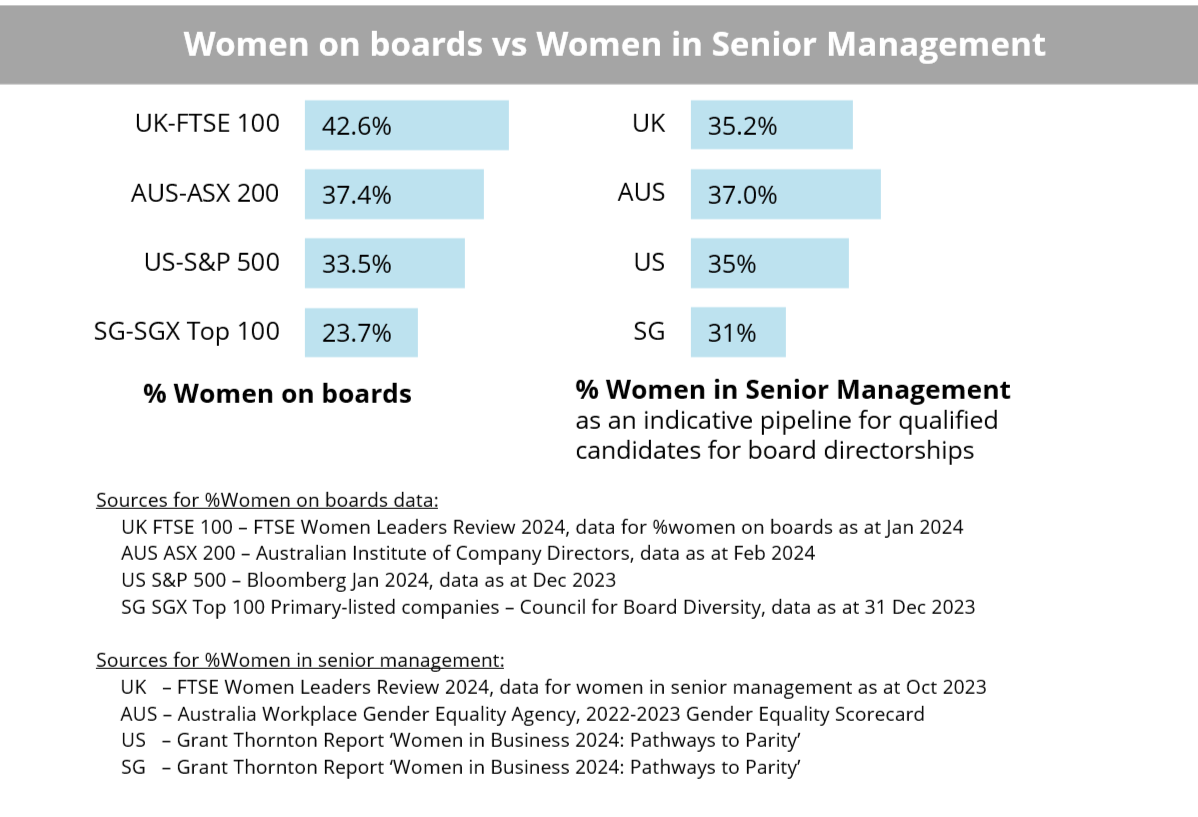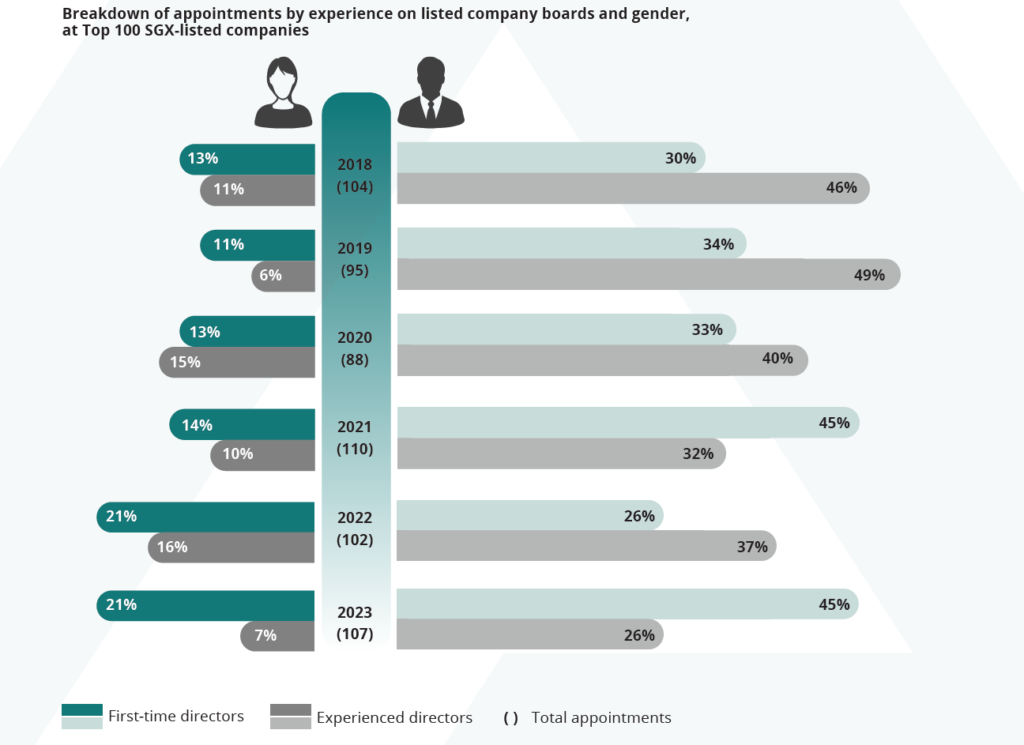About > Frequently Asked Questions
Frequently Asked
Questions
What is Board Diversity?
Board diversity sees boards having a dynamic balance and mix of skills, knowledge, experience, age, gender and other aspects of diversity relevant to the specific organisations. Having board diversity fosters constructive debate and avoid groupthink in the boardroom. CBD believes that diverse boards are catalysts to robust governance and better stewardship, and are valuable drivers for growth.
What is board gender diversity?
Why does CBD focus only on women on boards when it discusses board diversity?
Gender – one of the most visible and measurable aspects of diversity widely tracked by institutional investors, governments and interest groups – is a powerful and accessible lead-in to broader conversations on board diversity. As decision-makers consider having more women on their boards, they would naturally consider other aspects of diversity that will further contribute to the success of the organisation.
FAQ for Organisations
Visit Case for Diverse Boards for details.
- Adopt and disclose a clear board diversity policy and targets, which sets out how these enhance the company’s and board’s capability to create sustained performance over time
- Review board selection process and search criteria to account for diversity.
- Think beyond the typical board director profile.
- Broaden search parameters: background, skills, geography, age.
- Consider new/unfamiliar candidates based on how they can add value.
Eg. qualified women candidates in non-traditional fields such as academia, science, technology, non-profit, ESG.
- Cast the net wider. Compose a broader slate of candidates beyond personal networks. Specifically request for women, in addition to the skillset(s) required, to complement the board’s composition.
- Focus on the relevant skill sets, not prior board experience. Proactively seek out women directors who match your skills and needs matrix.
- Have at least 20-25% female candidates on the slate and interview at least one.
- Appoint women as Board Chair or to Nominating Committees to guard against unintentional gender bias and gain access to a broader network of candidates.
- Appoint more than one woman for the greatest impact.
Modern business practices are reinforcing the importance of having more than one woman on boards to create impact. More global institutional investors are voting against companies that don’t have at least two women on their boards, and competitive markets are setting a goal of at least 30% female representation. It is pertinent to consider that:
- Having only 1 WOB (i) could appear as tokenism, (ii) may suggest a narrow candidate pool, (iii) may leave board discussions insufficiently diverse and less equipped to produce broad-based solutions to address concerns of various stakeholders.
- Having at least two WOB – or ideally 30% WOB – can create ‘critical mass’1, improving the odds of women’s perspectives being heard2 and incorporated into decision making.
- For listed companies : SGX has amplified its focus on board diversity (including gender), requiring listed companies to set and disclose their targets to achieve diversity on boards. CBD encourages companies to set their targets at or above CBD’s goals of 25% WOB by 2025 and 30% by 2030 for Top 100 companies.
- Plan ahead to allow ample time for the approach and for highly sought-after board candidates to de-conflict (if necessary). If a woman director is stepping down, take steps to find another capable woman director to fill that position.
- Create active “talent spotting” practices internally and among your peer and professional set, so you have time to explore and cultivate relationships with possible candidates ahead of a placement need.
- Companies searching for candidates beyond what Singapore’s talent pool can offer (eg a unique technological expertise or expertise in specific overseas markets) can look beyond our shores. Companies in Europe have appointed women from other markets as board directors to complement discussions with their unique insights.
1Critical mass theory suggests that the risk of tokenism diminishes once women account for a certain proportion of board seats (in general, 30 percent). – IFC Board Gender Diversity in ASEAN Report 2019.
- 2 Individuals who are minorities or tokens in a group often self-censor. And even when they speak up, the majority group members may discount their views. – “Does Gender Diversity on Boards Really Boost Company Performance?”, Wharton University, May 2017.
- In order to reap the benefits of gender diversity, at least three women are needed to change the way the board is run and the way women are able to share their insights – Egon Zehnder Global Board Diversity Tracker 2018.
Using the number of women in senior management as a proxy to gauge the talent pool for board roles, the proportion of qualified women in Singapore is comparable to that of Australia, US and UK. However the percentage of women’s representation on Singapore boards is half of these countries’. (See chart below.)
At the same time, we witness the increasing appointment of Singapore women to international boards overseas.
Singapore Boards may find that the pool of candidates is much larger than expected if they look beyond traditional networks and re-examine the profile of board directors they seek.

Visit Finding Women Board Candidates for details.
CBD supports merit-based appointment of board directors. Every director must possess the necessary qualifications, skills and experience to contribute to the board.
For organisations to recruit the best candidates, regardless of gender, based on merit, we encourage organisations to:
- Look for candidates beyond personal networks and make use of other sources such as executive search firms and business network groups
- Engage in the search process at least a year or two ahead of board renewals to increase chances that the best candidates are not otherwise engaged in other commitments or have the time to de-conflict other priorities.
- Ensure that at least 20-25% of the candidates are women and aim to interview at least one woman candidate.
Also see answer to Question 2 on how to increase the number of women on your boards.

Chairman, SATS Ltd and Singapore Institute of Management; Former Deputy Chair, Shell plc.
The preference for known candidates, men or women, is common and convenient, with better board harmony cited as the main reason. But in practice, new board members are particularly conscious of sensitivities and are often more ready to put their points across in a non-confrontational and positive manner. Anecdotally, many boards that have appointed women directors have positive experiences, even among long-established businesses.
Progressive boards, which are in tune with organisational and stakeholder needs, are more likely to place greater priority on individual board members’ ability to contribute to and improve board discussions. Prior board experience is secondary.
Changes in business models – arising due to changes from technology to customer behaviours – necessitates harnessing different talents, experiences, and perspectives on boards. People with the necessary know-how could bring added value to boards’ deliberations, even if they may not have prior board experience.
Being open to considering board candidates without board experience would also vastly increase the pool of candidates that your board has to choose from.
Your board need not worry about board candidates having prior board experience, given that they are typically professionals who are successful in their organisations.
Appointing directors without prior board experience does not compromise standards.

Chairman, SingPost; Former Chair, Singtel
A local study (issued on 29 June 2018) by the National University of Singapore (NUS) Business School, using econometric techniques, established a relationship between board gender diversity and company’s financial performance, acting through corporate governance.
The establishment of a relationship is a necessary condition towards establishing a definitive causality between these two aspects. The study found that women independent directors, in particular, have a positive direct effect on financial performance (on average, adding one woman independent director is expected to improve financial performance by 11.8%).
Although causality has not been established, Board chairmen from leading companies in Singapore have agreed that the qualitative benefits of having a diverse board are clear.
Read more about what corporate leaders say about the NUS Business School’s findings here.
CBD is aware of studies in other markets that concluded that having women on boards does not impact financial performance. One of the more well-circulated contrarian reports was from Wharton University in May 2017, titled “Does Gender Diversity on Boards Really Boost Company Performance?”. However, the report suggests that the lack of impact of women on boards to financial performance was likely to be because:
- the women added to boards may not differ much in their values, experiences, and knowledge from the men who already serve on these boards; and
- women, being the minority, lack the influence to change board decisions.
The benefits that individual organisations are able to reap from having diverse boards depend largely on their ability to draw out differing views and encourage constructive debates in the decision-making process.
To avoid the situation where adding women makes no difference to a company’s performance, CBD encourages organisations to:
- Look beyond the pool of same-old same-old candidates (even if they are females). The true benefits of diversity can be better obtained from people who are outside their usual circle. Women, many of whom are not on the boards now, can bring with them much-needed fresh perspectives.
- Have at least two to three women directors to improve the odds of their perspectives being heard. When women are not viewed as a minority by the rest of the board, it enables them to contribute more effectively.
The issue of low WOB in Singapore may not correct itself over time given that CBD found that the key reasons for organisations’ inaction are:
- Boards have no impetus to change.
- Boards with only one woman director think that they have done their part.
- Boards’ perception of a shortage of qualified women (see question 3).
- Few vacancies for new director appointments due to infrequent board refreshment. Where there are board openings, boards tend to appoint more men than women, whether experienced or otherwise (see chart).

SGX RegCo’s nine-year cap on director independence, which seeks to promote renewal and succession planning, could help. SGX RegCo CEO Tan Boon Gin said: “[This provides] an opportunity for companies to inject new skills, experience and knowledge into their boards, all of which will be invaluable in guiding the business for the long term..”
If female participation remains at current levels, organisations risk their leadership being viewed as less competitive on the global market, especially with investors who measure a company’s future performance by the perceived quality of its board and management.
Case for Setting Targets for Women on Boards
Large organisations are able to mobilise more resources when looking into policy needs, processes and implementation.
The experience of large organisations in searching for and appointing women directors will bring more public attention to this issue and add momentum for other organisations to follow.
The need to face the diversity issue is also more immediate for large companies. Large companies are more exposed to international investor scrutiny and board diversity is increasingly being viewed by global investors as an indicator of stewardship and governance. Gender equality is one of the Sustainable Development Goals set by the United Nations and observed by asset owners who sign up to the Principles of Responsible Investment which accounts for over USD120 trillion as of 31 March 2021.
CBD had conducted a feasibility study before setting the targets. It is achievable with the active participation of all organisations and boards. Singapore has a significant proportion of women in senior management positions, many of whom who are willing and able to contribute on boards if given the opportunity.
CBD’s target is ambitious but attainable. Top 100 listed companies can achieve the target of having 25% of board seats held by women by 2025 if each company has 2 to 3 women on board, given the average board size of 9. Statutory boards and Top 100 IPCs, with average board size of 14, can achieve the target of 30% women on boards if each organisation has 4 to 5 women on its board. Both statutory boards and IPCs have crossed the 30% milestone in 2022 and 2023 respectively.
Yes, it would. But we are interested in women on boards for the benefits that it brings. Meeting the numbers does not guarantee ensuing benefits. We are investing the effort to convince key board decision-makers and market participants that organisations with diverse boards do better. In harnessing opportunities and managing risk, it is indisputible that diversity beats tunnel vision hands down.
Where organisations willingly embrace board diversity, more effort is likely to be invested in making the arrangement work well than if numbers were met for compliance without enthusiasm.
While both targets and quotas are specific measurable objectives with discrete timeframes in which they are to be achieved, there are key differences between the two:
- Targets are voluntary and set by an organisation at their own discretion, with discrete timeframes in which they are to be achieved. Consequences for not meeting a target may be set and enforced as the organisation sees fit.
- Quotas are mandatory and usually set externally by a body with authority to impose them on organisations (for example, the Parliament). Establishing quotas usually includes setting penalties for failing to meet them. These are enforced by a body external to an individual company and are non-negotiable by individual organisations.
Adapted from: Australia’s Workplace Gender Equality Agency
FAQ for Women
Women make up half the population, the workforce and customer base of many organisations. It is important that boards are gender balanced to ensure that organisations are relevant to their stakeholders. The sharing of your professional experiences, as well as your fresh perspective on issues within the boardroom will be the catalyst for organisations to become stronger, more relevant and sustainable in the long-term.
Step 1: Understand what it takes to be a board director by learning from experienced directors and first-time women directors. Read more on Preparing for a Board Role here.
Step 2: Get trained on how to be an effective board director. Organisations such as Singapore Institute of Directors, Singapore Institute of Chartered Accountants, Singapore Management University, INSEAD provide board training.
Step 3: Get tips on how to get on a board. Read more on Preparing for a Board Role here.
There are various executive search firms or board matching services that you may wish to reach out to:
- Executive search firms – for board roles in statutory boards and listed companies
- Board matching services – for board roles in listed companies and charities
Visit this page for a list of Executive Search Firms and board matching organisations.
CBD offers various channels to support aspiring women board directors. Please get in touch with us to share your experience as a female board director.
FAQ for Potential Partners and Media
CBD approaches women on boards as a business imperative and a matter of good governance in order for organisations to meet their objectives amidst uncertainty and change. CBD works with like-minded organisations keen on improving governance through increasing board diversity, including gender.
CBD is the official source for statistics on women’s representation on boards. We publish statistics yearly and share the progress of women’s participation on boards for each of the largest 100 organisations.
Visit this page to access these statistics.
Finding Women Board Candidates
Learn more about
the avenues available
Register Your
Interest
If you are interested
in board directorships
Readings on
Board Diversity
Visit our Resources section
for related readings
